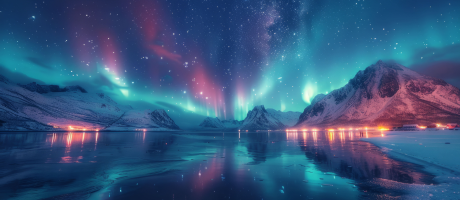Blog Posts & Blog Archives
All Blogs / traveller-diaries
The Northern Lights Aurora Borealis
Explore the science and beauty of the Northern Lights. Learn about their origins, colors, and best viewing spots for an unforgettable aurora experience.
Friday, June 21, 2024
The Northern Lights Aurora Borealis
The Northern Lights, also known as the Aurora Borealis, are one of nature's most breathtaking spectacles. This stunning light show in the polar skies has fascinated humans for centuries, inspiring myths, legends, and scientific inquiry. But what causes the Northern Lights? In this blog, we'll explore the origins of the Aurora Borealis, the science behind this mesmerising phenomenon, and why it continues to captivate observers around the world. Interactions between charged solar particles and the Earth's magnetic field produce the Aurora Borealis. 1.Solar Wind: The sun constantly emits a stream of charged particles, known as the solar wind, into space. These particles include electrons and protons. 2.Magnetic Field Interaction: When the solar wind reaches Earth, it interacts with our planet's magnetic field. The Earth's magnetic field acts as a shield, deflecting most of these charged particles away. However, some particles are trapped by the magnetic field and funnelled towards the polar regions. 3.Atmospheric Collision: As these charged particles travel along the magnetic field lines and enter the Earth's atmosphere, they collide with gas molecules, such as oxygen and nitrogen. These collisions release energy in the form of light, creating the vibrant colours of the aurora. 4.Geomagnetic Storms: During periods of heightened solar activity, such as solar flares or coronal mass ejections, the solar wind can become particularly intense, leading to geomagnetic storms. These storms enhance the aurora, making the Northern Lights even more spectacular. The Northern Lights display a variety of colours, each resulting from the interaction of charged particles with different types of gas molecules: ● Green: The most common colour of the Aurora Borealis is green, caused by collisions with oxygen molecules at altitudes of around 60 to 150 miles above the Earth. ● Red: Less common, red auroras occur at higher altitudes (above 150 miles) and are also produced by oxygen molecules. The red colour is typically seen at the tops of auroral displays. ● Purple and Blue: These colours are created by interactions with nitrogen molecules. Purple and blue auroras tend to occur at lower altitudes (below 60 miles) and are less frequently observed. The Earth's magnetic field plays a crucial role in the formation and appearance of the Northern Lights. This magnetic field, generated by the movement of molten iron within the Earth's core, extends into space and creates a protective barrier known as the magnetosphere. The magnetosphere deflects most of the solar wind, but the polar regions, where the field lines converge, allow charged particles to enter the atmosphere, leading to the formation of auroras. Geomagnetic storms, triggered by solar flares or coronal mass ejections, significantly enhance auroral activity. These storms increase the number and energy of charged particles entering the Earth's atmosphere, resulting in brighter and more widespread auroras. During intense geomagnetic storms, the Northern Lights can sometimes be seen at lower latitudes, far from their usual polar regions. The best places to observe the Aurora Borealis are within the auroral oval, a region centred around the magnetic poles where auroral activity is most frequent. Ideal locations include: ● Northern Norway: Tromso and the Lofoten Islands are popular spots for aurora hunting. ● Iceland: The remote and dark landscapes of Iceland provide excellent viewing conditions. ● Sweden: Abisko National Park is renowned for its clear skies and high auroral activity. ● Finland: Lapland offers numerous opportunities for witnessing the Northern Lights. ● Canada: The Yukon, Northwest Territories, and northern Alberta are prime aurora-viewing destinations. ● Alaska: Fairbanks is a well-known location for experiencing the Aurora Borealis. Winter is the ideal season to observe the Northern Lights because of the long, dark evenings. Clear skies and minimal light pollution are essential for optimal viewing conditions. Late evening to early morning hours are typically the most active times for auroral displays. The Aurora Borealis's Mysteries and Magic The Aurora Borealis has inspired awe and wonder throughout history. Indigenous cultures in the Arctic regions have numerous legends and myths about the Northern Lights. Some believed the lights were spirits of ancestors or animals, while others saw them as celestial omens. Today, the Northern Lights continue to captivate scientists and adventurers alike. Advances in technology, such as aurora forecasting and real-time alerts, have made it easier than ever to witness this natural phenomenon. However, the experience of standing under a sky illuminated by the shimmering dance of the Aurora Borealis remains a profoundly magical and humbling encounter with nature's beauty and power. The Northern Lights, or Aurora Borealis, are evidence to the dynamic and interconnected nature of our planet and its relationship with the sun. From the charged particles of the solar wind to the magnetic field's protective embrace, the aurora is a spectacular display of the forces at work in our universe. Whether you are a scientist seeking to understand the underlying mechanisms or a traveller yearning to witness their beauty firsthand, the Northern Lights offer a glimpse into the wonders of our natural world. So, bundle up, head north, and prepare to be amazed by the celestial ballet of the Aurora Borealis. What Causes the Northern Lights?
The Colours of the Aurora Borealis
The Role of the Magnetic Field
Geomagnetic Storms and Auroral Activity
Where and When to See the Northern Lights
Conclusion:
Related Blogs
Saudi Arabia Capital Hidden Treasures: Riyadh
Discover Riyadh's landmarks, cuisine, culture, and recreation. Perfect for tourists seeking an authentic Arabian experience.
By WelinkJobs | Friday, April 26, 2024
Trekking Through Majestic Himalayas
Join us on a virtual trek through the Himalayas, exploring its stunning landscapes, diverse cultures, and thrilling challenges.
By WelinkJobs | Friday, May 17, 2024



